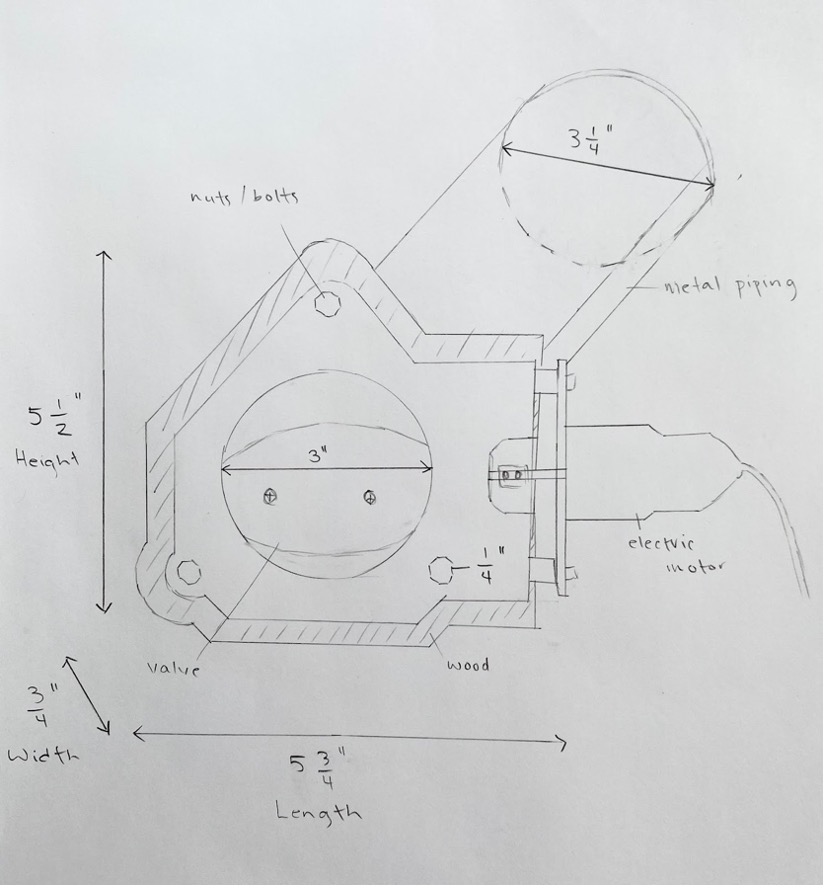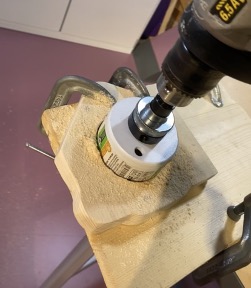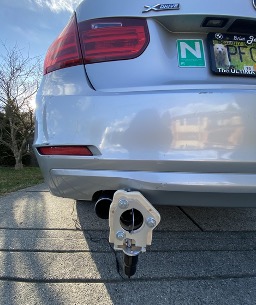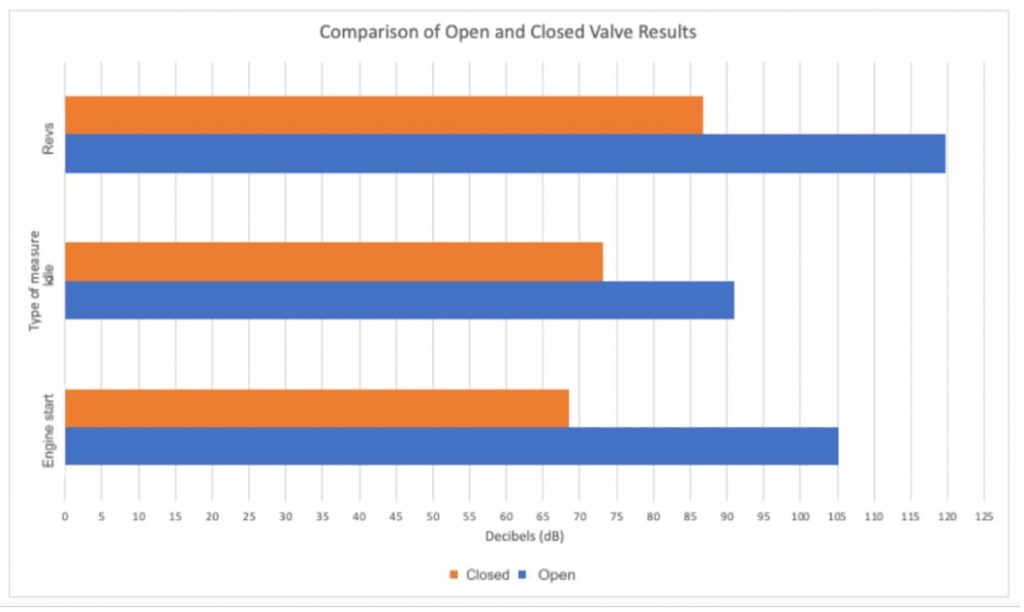Patrick Handra, Year 2 Engineering.
Abstract
Modified exhaust systems are extremely disputed against for their intense sound level. However, a valve system allows the driver to control the level of exhaust noise. This project aims to prevent attention drawn to loud cars with a design in which the valve mounts directly to the exhaust tip. A general design was first sketched for the concept of the system. Afterwards, the system was built using a wood frame. Results were gathered from engine start, measured idle, and revs. The desired results to see a decrease in exhaust noise (decibels) were largely achieved with an overall drop of 36.6 dB for engine start, 17.8 dB for measured idle, and 32.9 dB for revs.
Introduction
One of the most common modifications to enhance the sound of a car is to replace the exhaust system (Sidhu, 2021). However, most of these cat-back or axle-back systems exceed the legal noise limit of 83 decibels (dB) from factory, which can result in a $598 fine (Sears, 2020). Decibels are measured in factors of powers of ten, meaning that a sound 10 times more powerful than 0 dB is 10 dB. A sound 100 times more powerful than 10 dB is 20 dB, 1000 times more powerful is 30 dB, 40 dB and so on (Roberts, 2003). With a valve system, people can be more considerate while driving in disruptive situations. This project aims to prevent attention drawn to loud cars. While there are already many types of mufflers, and sound dampening systems, a valve system allows the driver to control the level of exhaust noise (Shinde et al., 2019). The design for this project was inspired by a valve system with a similar purpose, however through a different approach. In my design, the valve mounts directly to the exhaust tip, and is controlled through a wireless remote. This system would best serve its purpose for cars with an aftermarket or modified exhaust.
Materials and Methods:
Designing: First, a general design was sketched for the concept of the system, including dimensions (see Figure 1).
Building: The frame was created using a 1×10” plank of lumber, a thick and uniform wood designed to hold everything together. The outline of the shape was drawn on the wood using pencil. The outline was cut out with an electric jigsaw (Mastercraft), and the hole for the valve clearance was made with an electric drill (Craftsman) with a 3” hole saw. During this process, the wood was secured in place with basic c-type clamps (see Figure 2). Once the desired shape was attained, the wood was sanded down with 150 grit sandpaper (3M), to smoothen out all the edges. The metal piping was created using an old can with a 3 ¼” diameter, and both ends were opened with a can opener, to make a pathway for the exhaust. The can was attached to the wooden frame with epoxy (Gorilla Glue) and left to cure overnight with a 25lbs plate on top of the can creating pressure to the epoxy weld. The exhaust valve and motor (PQYRACING) were attached to the frame using three ¼” bolts, washers, and butterfly nuts. Once everything was assembled, the project reached its final stage (see Figure 3).
Testing: For testing, the system was mounted to the exhaust of a stock 2013 BMW 328i, and the wiring kit (EVIL ENERGY) containing the electronics, and wireless remote, was routed under the car and into the center console (see Figure 4). The results are acquired from three sequences: engine start, measured idle, and revs. These three things will be measured while the valve is both open and closed. Data was collected using Decibel X, an app that measures sound in decibels. The phone microphone was consistently held by hand within an inch of the exhaust tip, and the results were averaged.

Figure 1 Original sketch.

Figure 2 Cutout process.

Figure 3 Final product.

Figure 4 Testing stage.
Results
Results were gathered from the following: engine start, measured idle, and revs. Each test was repeated three times then averaged. Averaged results from engine start indicated a decrease of 36.6 dB, measured idle dropped by 17.8 dB, and revs were reduced by 32.9 dB, while comparing valve open versus closed (see Figure 5).

Figure 5 Open/closed comparison.
Discussion
This project successfully reached its stated goal to reduce exhaust noise and control the sound level through a valve. The desired results were substantially fulfilled and demonstrated a notable change in sound. While it may not be as clear to the human ear, the difference in decibels (factors of powers of ten) can be significantly quieter (Wilke, 2020). To conceptualize the results, prolonged exposure to noise over 85 dB can cause permanent damage to your hearing (Olaolu et al., 2007). This means that the valve system was able to attain a notable effect.
Minor human error may have occurred while gathering results, since the sequence was hard to match a second time. Holding the phone microphone by hand may have also been a source of error affecting the experiment. If more resources were available, testing in an enclosed or sound proofed area and having proper sound measuring equipment would have increased the accuracy in results. However, when disregarding these factors, this project has overall achieved its purpose.
References
Olaolu, Adetona, and Rotimi Godwin. “NOISE – INDUCED HEARING DAMAGE.” 2007, http://sdngnet.com/Files/Lectures/FUTA-ARC-507/Assignments/2007%20Assignments/Term%20Papers/Noise%20Induced%20Hearing%20Damage.pdf. Accessed 16 April 2022.
Roberts, B.L. “The Decibel Scale.” Physics, 10 February 2003, http://g2pc1.bu.edu/~roberts/py231/db3.pdf. Accessed 27 March 2022.
Sears, Chantal. “BC RCMP – Fall update on loud vehicle enforcement in White Rock.” RCMP, 3 November 2020, https://bc-cb.rcmp-grc.gc.ca/ViewPage.action?siteNodeId=2087&languageId=1&contentId=66635. Accessed 23 March 2022.
Shinde, Prasad. “A Review on Muffler Design for Exhaust Noise Attenuation.” International Journal of Engineering and Technology, 2019. https://www.researchgate.net/profile/Prasad-Shinde-5/publication/318657561_A_Review_on_Muffler_Design_for_Exhaust_Noise_Attenuation/links/5ecc0a57299bf1c09adf4aa6/A-Review-on-Muffler-Design-for-Exhaust-Noise-Attenuation.pdf. Accessed 23 March 2022.
Sidhu, Andleeb. “How to Make Your Car Sound Better – Automotive News.” My Auction Sheet, 6 May 2021, https://myauctionsheet.com/blog/how-to-make-your-car-sound-better/. Accessed 23 March 2022.
Wilke, Carolyn. “Scientists Say: Decibel.” Science News for Students, 3 February 2020, https://www.sciencenewsforstudents.org/article/scientists-say-decibel. Accessed 16 April 2022.